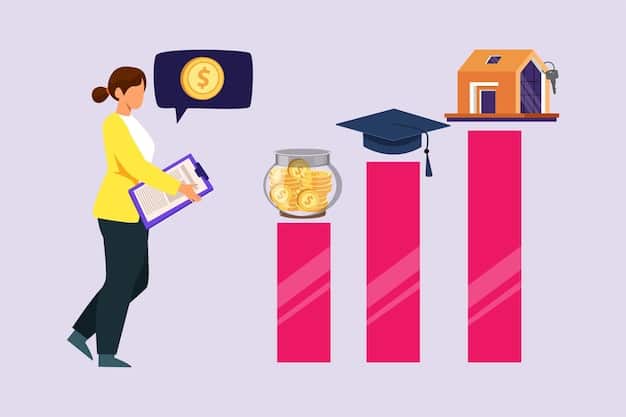Grants vs Loans: A US Student’s Guide to Financial Aid

Understanding the difference between grants and loans is crucial for US students seeking financial aid, as grants are typically need-based and don’t require repayment, while loans must be repaid with interest.
Navigating the world of financial aid can be daunting for any US student. Among the many options available, understanding the difference between grants and loans is paramount. This guide breaks down the key distinctions, helping you make informed decisions about funding your education.
Understanding Federal Grants for US Students
Federal grants are a cornerstone of financial aid for many US students. These grants, primarily need-based, aim to provide crucial financial assistance to students who might otherwise find higher education inaccessible. Let’s delve deeper into what makes federal grants a valuable option.
The Pell Grant: A Foundation of Federal Aid
The Pell Grant is often the first stop for students exploring federal grant options. It’s designed to assist undergraduates with exceptional financial need who have not yet earned a bachelor’s or professional degree.
Federal Supplemental Educational Opportunity Grant (FSEOG)
The FSEOG program is another need-based grant, but it’s administered directly by participating colleges and universities. Funds are limited, so priority is typically given to students with the greatest financial need, particularly those who receive Pell Grants.

- Eligibility Requirements: Pell Grants require students to demonstrate significant financial need, typically determined by the information provided on the Free Application for Federal Student Aid (FAFSA).
- Award Amounts: The maximum Pell Grant award changes annually and is dependent on factors such as the student’s Expected Family Contribution (EFC), the cost of attendance at their school, and their enrollment status (full-time or part-time).
- Application Process: To apply for a Pell Grant, students must complete the FAFSA. The FAFSA collects financial information about the student and their family to determine eligibility for federal student aid.
- Renewal Criteria: Pell Grants can be renewed each year, provided the student continues to demonstrate financial need and maintains satisfactory academic progress.
Federal grants provide a critical pathway to higher education for countless US students. By understanding the eligibility requirements, application processes, and renewal criteria, students can maximize their chances of receiving this valuable financial support.
Exploring Federal Student Loans in the US
Federal student loans play a significant role in financing higher education for many students in the US. Unlike grants, loans require repayment with interest, making it essential to understand the different types and their implications. Let’s explore the landscape of federal student loans.
Direct Subsidized Loans
Direct Subsidized Loans are available to undergraduate students who demonstrate financial need. A key benefit of these loans is that the US Department of Education pays the interest while the student is in school, during the grace period, and during deferment.
Direct Unsubsidized Loans
Direct Unsubsidized Loans are available to both undergraduate and graduate students, and eligibility is not based on financial need. Interest accrues from the time the loan is disbursed, even while the student is in school.

- Loan Limits: The amount students can borrow through federal student loans varies depending on their year in school and dependency status. Limits are typically higher for independent students and graduate students.
- Interest Rates: Interest rates for federal student loans are set by Congress and can change annually. It’s crucial to understand the interest rate before accepting a loan, as it impacts the total cost of repayment.
- Repayment Options: Federal student loans offer a range of repayment options, including standard, graduated, and income-driven repayment plans. Income-driven plans can be particularly helpful for borrowers with lower incomes.
- Loan Forgiveness Programs: Several loan forgiveness programs are available for borrowers working in certain public service professions, such as teaching, healthcare, and government service.
Federal student loans provide a vital means for many US students to access higher education. By understanding the terms, conditions, and repayment options, borrowers can manage their debt effectively and avoid potential financial pitfalls.
US State Grants and Loan Programs: An Overview
Beyond federal aid, many US states offer their own grant and loan programs to assist students pursuing higher education. These programs can provide additional financial support and may have different eligibility requirements than federal programs. Let’s take a look at what state-level aid entails.
Grant Opportunities at the State Level
The specific eligibility requirements and award amounts vary greatly from state to state.
State grants are typically need-based and designed to help students who demonstrate financial need. They can be a valuable supplement to federal grants, helping to cover the full cost of attendance at a college or university.
State Loan Programs: Filling the Funding Gaps
Some states offer their own loan programs, which may have different interest rates, terms, and conditions than federal student loans. These programs can be an option for students who have exhausted federal loan options or who are seeking more favorable terms.
- Researching State-Specific Programs: Students should research the grant and loan programs available in their state of residence. State higher education agencies often provide comprehensive information on available resources.
- Eligibility Criteria: State grant and loan programs may have specific eligibility criteria, such as residency requirements, GPA minimums, or enrollment in specific types of programs.
- Application Deadlines: State aid programs often have strict application deadlines, so it’s crucial to apply early and ensure all required documentation is submitted on time.
- Stacking with Federal Aid: State aid programs can often be combined with federal aid to provide a more comprehensive financial aid package.
State grants and loan programs offer a valuable complement to federal aid, helping US students bridge the gap in funding their education. By researching and understanding the programs available in their state, students can maximize their financial aid options.
Private Loans and Grants for US Students
In addition to federal and state aid, private loans and grants can provide additional funding options for US students. These sources, typically offered by banks, credit unions, and private organizations, may have different eligibility requirements and terms than government-sponsored programs. Let’s explore the world of private aid.
Understanding Private Student Loans
Private student loans can be an option for students who need to borrow beyond the limits of federal loans or who do not qualify for federal aid. However, private loans often come with higher interest rates and fewer borrower protections than federal loans.
Private Grants and Scholarships: Additional Opportunities
Numerous private organizations and foundations offer grants and scholarships to students pursuing higher education. These awards can be based on academic merit, financial need, field of study, or other criteria.
- Interest Rates and Fees: Private loans often have variable interest rates, which can fluctuate over time. They may also come with origination fees or other charges.
- Creditworthiness: Private lenders typically require borrowers to have good credit or a cosigner with good credit.
- Repayment Terms: Repayment terms for private loans can vary, but they may be less flexible than federal loan repayment options.
- Researching Opportunities: Students should research private grants and scholarships thoroughly, using online databases, college financial aid offices, and other resources.
Private loans and grants can supplement federal and state aid, providing additional funding for US students. By understanding the terms, conditions, and potential risks, borrowers can make informed decisions about leveraging private aid to finance their education.
How Grants Impact Student Debt in the US
Grants play a critical role in reducing student debt for US students. As “free money” that doesn’t require repayment, grants can significantly lower the amount students need to borrow in loans. Let’s examine the impact of grants on student debt levels.
Minimizing Loan Reliance with Grants
By tapping into grant opportunities, students can reduce their reliance on loans, thereby minimizing their total debt burden upon graduation. This can have a positive impact on their financial future.
The Ripple Effect of Grant Aid
Grants can also have a ripple effect, reducing the need for students to work long hours during college, allowing them to focus more on their studies and potentially graduate sooner.
- Long-Term Financial Health: Lower student debt can lead to improved long-term financial health, making it easier for graduates to save for retirement, buy a home, or start a family.
- Economic Impact: Reduced student debt can also have a positive impact on the economy, as graduates have more disposable income to spend and invest.
- Equity and Access: Need-based grants can promote equity and access to higher education, ensuring that talented students from all backgrounds have the opportunity to pursue their dreams.
- Maximizing Grant Opportunities: Students should explore all available grant opportunities and apply for as many as possible to maximize their financial aid package and minimize their reliance on loans.
Grants serve as a powerful tool in mitigating student debt for US students. By leveraging grant aid, students can achieve their educational goals while minimizing their financial burden and paving the way for a brighter future.
Effective Strategies for Managing Student Loans in the US
Managing student loans effectively is crucial for US graduates. With careful planning and informed decision-making, borrowers can navigate the repayment process and minimize the long-term financial impact of their student debt. Let’s explore some effective strategies for managing student loans.
Understanding Repayment Options
Familiarize yourself with the various repayment options available, including standard, graduated, and income-driven repayment plans. Choose the plan that best aligns with your income and financial goals.
Prioritizing Loan Consolidation
Consider consolidating your federal student loans to simplify repayment and potentially lower your interest rate. Loan consolidation combines multiple loans into a single loan with a weighted average interest rate.
- Budgeting and Financial Planning: Create a budget to track your income and expenses, and prioritize your loan payments. Consider consulting with a financial advisor for personalized guidance.
- Exploring Loan Forgiveness Programs: If you work in a qualifying public service profession, explore loan forgiveness programs such as Public Service Loan Forgiveness (PSLF).
- Avoiding Default: Make your loan payments on time to avoid default, which can have serious consequences for your credit score and financial future.
- Seeking Assistance: If you’re struggling to make your loan payments, contact your loan servicer to discuss options such as deferment or forbearance.
Effective student loan management requires proactive planning and informed decision-making. By understanding your repayment options, budgeting wisely, and exploring loan forgiveness programs, you can navigate your debt successfully and achieve your financial goals.
| Key Point | Brief Description |
|---|---|
| 💰 Grants | Free money that doesn’t require repayment, often need-based. |
| 🏦 Loans | Money that must be repaid with interest, available federally and privately. |
| ✍️ FAFSA | The application used to determine eligibility for federal student aid. |
| 💼 Loan Forgiveness | Programs that forgive student loan debt for those working in public service. |
Frequently Asked Questions (FAQ)
▼
Grants are essentially free money that you don’t have to pay back, while loans are borrowed money that you must repay with interest. Grants are usually need-based, while loans can be need-based or not.
▼
To apply for federal grants and loans, you need to fill out the Free Application for Federal Student Aid (FAFSA). This form collects your financial information to determine your eligibility for various federal aid programs.
▼
Some common types of federal grants include the Pell Grant and the Federal Supplemental Educational Opportunity Grant (FSEOG). The Pell Grant is for undergraduates with financial need, while the FSEOG is administered by participating schools.
▼
If you need more money, consider private student loans or look into state-sponsored aid programs. Private loans typically come with higher interest rates, so carefully evaluate your options and borrowing needs.
▼
Income-driven repayment plans are federal student loan repayment options that base your monthly payment on your income and family size. These plans can be helpful if you have a lower income or are struggling to afford your loan payments.
Conclusion
Understanding the nuances between grants and loans is paramount for students in the US seeking financial aid. Grants offer a valuable opportunity to reduce debt, whereas loans require careful management and repayment planning. By exploring all available options and making informed decisions, students can pave the way for a successful and financially stable future.





